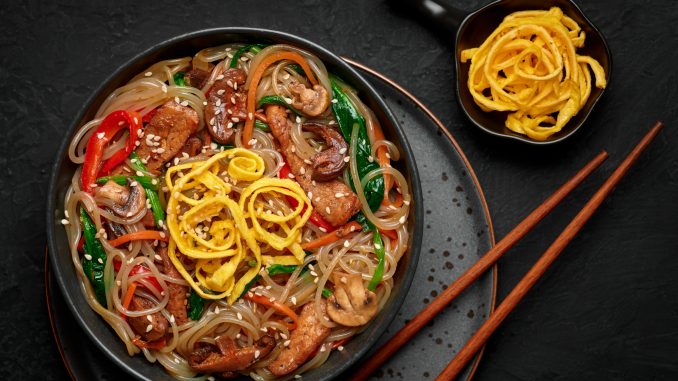
Japchae is a traditional Korean dish known for its vibrant colors, delightful textures, and harmonious flavors. It is a popular dish that is often served on special occasions or as a part of celebratory meals.
Japchae primarily consists of glass noodles made from sweet potato starch, which are cooked until tender. The noodles have a slightly chewy texture and a translucent appearance. They provide a neutral base for the dish, allowing the other ingredients to shine.
The dish features a colorful array of stir-fried vegetables. Common vegetables used in Japchae include thinly sliced carrots, bell peppers, onions, spinach, mushrooms (such as shiitake or oyster mushrooms), and sometimes julienned zucchini. The vegetables are cooked to retain their crispness, adding a variety of textures to the overall dish.
Japchae often includes thinly sliced beef, although vegetarian or vegan variations are also popular. The beef is typically marinated in a mixture of soy sauce, sesame oil, garlic, and other seasonings before being stir-fried until tender. The savory and umami-rich flavor of the beef complements the vegetables and noodles.
To enhance the taste, Japchae is typically seasoned with a combination of soy sauce, sesame oil, sugar, and sometimes a hint of black pepper. These seasonings contribute to the dish’s overall balance of flavors, creating a harmonious blend of sweet, savory, and nutty notes.
To garnish the dish, toasted sesame seeds are often sprinkled on top. This adds a delightful crunch and imparts a nutty aroma to the Japchae.
Japchae is not only a visually appealing dish but also a flavorful and nutritious one. Its combination of fresh vegetables, tender noodles, and well-marinated meat (if included) provides a satisfying and wholesome eating experience.
Overall, Japchae is a beloved Korean dish that showcases the country’s culinary expertise, with its beautiful presentation, variety of textures, and harmonious flavors.
The recipe serves 4 people.
Ingredients:
- 8 ounces (225g) sweet potato glass noodles (also known as dangmyeon)
- 8 ounces (225g) thinly sliced beef (you can use ribeye, sirloin, or tenderloin)
- 2 tablespoons vegetable oil
- 2 cloves garlic, minced
- 1 medium onion, thinly sliced
- 1 carrot, julienned
- 1 bell pepper, thinly sliced
- 4 ounces (115g) fresh spinach
- 4-6 shiitake mushrooms, thinly sliced
- 2 tablespoons soy sauce
- 2 tablespoons sesame oil
- 1 tablespoon sugar
- 1/2 teaspoon black pepper
- Toasted sesame seeds, for garnish
Preparation:
- Bring a pot of water to a boil and cook the sweet potato glass noodles according to the package instructions. Drain and rinse with cold water. Set aside.
- In a bowl, marinate the thinly sliced beef with 1 tablespoon of soy sauce and 1 tablespoon of sesame oil. Let it sit for about 10 minutes.
- Heat 1 tablespoon of vegetable oil in a large skillet or wok over medium-high heat. Add the marinated beef and stir-fry until cooked through. Remove the beef from the pan and set aside.
- In the same skillet, add another tablespoon of vegetable oil. Sauté the minced garlic until fragrant, then add the sliced onion, julienned carrot, and bell pepper. Stir-fry for about 3-4 minutes until the vegetables are slightly tender.
- Add the shiitake mushrooms to the skillet and continue stir-frying for another 2-3 minutes until the mushrooms are cooked.
- Blanch the fresh spinach in boiling water for about 30 seconds, then transfer to a bowl of ice water to cool. Drain and squeeze out any excess water. Cut the spinach into bite-sized pieces.
- Add the cooked glass noodles, beef, and spinach to the skillet with the vegetables. Stir in the remaining tablespoon of soy sauce, sesame oil, sugar, and black pepper. Mix everything together until well combined and heated through.
- Remove from heat and transfer the Japchae to a serving platter. Sprinkle toasted sesame seeds over the top for garnish.
- Serve Japchae warm as a main dish or as a side dish alongside other Korean dishes.
Note: Feel free to adjust the seasonings according to your taste preferences. You can also customize the vegetable selection based on your preference or availability.
Leave a Reply